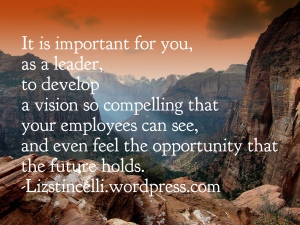Monthly Archives: March 2015
Why is a Compelling Vision so Important?
“Don’t underestimate the power of your vision to change the world. Whether that world is your office, your community, an industry, or a global movement, you need to have a core belief that what you contribute can fundamentally change the paradigm or way of thinking about problems.” —Leroy Hood
By Elizabeth Stincelli, DM
Vision
Your vision provides you with a description of the future that fulfills a deep hope within you. It clarifies where you want to go on an individual, team, and organizational level. Defining your vision helps you determine what skills, knowledge, tools, technologies, and abilities you will need to get from here to there. Having a compelling vision is not negotiable; it impacts the motivation, energy, and inspiration of yourself, your team, and your organization. As a leader, why should you promote a compelling vision in your organization and how can you do it?
Motivation
Les Brown believes, “Wanting something is not enough. You must hunger for it. Your motivation must be absolutely compelling in order to overcome the obstacles that will invariably come your way.” When employees’ lack a clear vision of where they are going, they often feel unmotivated and uncommitted; they feel their time and talent are going to waste. This is the perfect recipe for everyone to start working on their own agenda, and that is the perfect storm for your organization to fail to achieve the vision you have set. In order to keep everyone motivated, you must create a compelling, shared vision of the future where everyone wins.
Energy
Oprah Winfrey feels that, “Passion is energy. Feel the power that comes from focusing on what excites you.” When your employees have a clear and compelling vision, it unleashes the energy within them that will move them towards that vision. Help them to see what winning will look like and then link your vision to that picture. Tap into shared attitude, core values, and beliefs for the energy to keep moving forward and doing whatever it take to achieve your vision.
Inspiration
Ella Fitzgerald said, “Just don’t give up trying to do what you really want to do. Where there is love and inspiration, I don’t think you can go wrong.” When the vision for your organization fits into the values, ideas, and activities that inspire your employees they will be more committed, more productive, and more loyal. Inspire your employees by making your vision come alive for them; show them how important the role they play is in the big picture. Help them to envision how the future looks for them and inspire them with a deep sense of purpose. Reassure them that they are part of something meaningful, something greater than themselves.
Develop a Compelling Vision
If you don’t know where you are going, how will know what you need to get there? A compelling vision is important on an individual level and becomes even more essential as it spreads to teams, communities, and organizations. It is important for you, as a leader, to develop a vision so compelling that your employees can see, and even feel the opportunity that the future holds. Use your vision to motivate, energize, and inspire employees to work with you toward building that future.
© 2015 Elizabeth Stincelli
Elizabeth Stincelli is passionate about recognizing and inspiring the leader in each of us. She is the CEO of Stincelli Advisors where she focuses on helping organizations engage employees and improve organizational culture. Elizabeth holds a Doctor of Management degree with an emphasis on organizational leadership.
Learn more about Elizabeth by visiting her website, stincelliadvisors.com and connect with her on Twitter @infinitestin, Google+, and LinkedIn. You can contact her by email at stincelliadvisors@gmail.com.
The Foundation of Leadership: Trust
“Trust is the glue of life. It’s the most essential ingredient in effective communication. It’s the foundational principle that holds all relationships.” —Stephen Covey
By Elizabeth Stincelli, DM
Trust
The most important leadership characteristic is the ability to inspire trust. Without it, teams will never reach their full potential and relationships will suffer. As a leader you must be intentional about building trust in your organization. Trust has to be a two-way street. Set the example; be trustworthy yourself and show others that you trust them. A culture of trust boosts motivation, increases job satisfaction, and results in greater productivity. So, how do you build a foundation of trust?
Speak freely
Frederick Douglass said, “To suppress free speech is a double wrong. It violates the rights of the hearer as well as those of the speaker.” Employees, customers, and suppliers should know that they are welcome to speak freely with you. This will result in the sharing information more readily. What valuable information might you miss out on if others do not trust that they can speak freely with you? Provide a safe space where discussion, debate, and problem-solving can happen. Build employee confidence in knowing that you have their best interests at heart. And, always communicate directly with employees; don’t let them hear it from someone else first.
Act without fear
Charles Stanley explained, “Fear stifles our thinking and actions. It creates indecisiveness that results in stagnation.” Employees must know that you trust them to make the right decision and must feel comfortable enough to act without fear. When you develop a solid foundation of trust in your organization, employees will move outside of their comfort zones, feel confident exploring new ideas, will act freely, and be more willing to take on risk. Instill the courage in your employees that will encourage them to make the decisions and share the new ideas that will continue to move your organization forward.
Control over work
Margaret Wheatley tells us, “Even though worker capacity and motivation are destroyed when leaders choose power over productivity, it appears that bosses would rather be in control than have the organization work well.” Pixar is so successful because they have developed a culture that believes that everyone possesses a slice of genius. Your employees have skills and knowledge specific to their work; seek their input in areas where they have the knowledge and experience you are lacking. Delegate as much responsibility and control over tasks and projects as possible to employees and teams. Respect and value the diversity of ideas that employees have to offer. Show that you trust them to have control over their work and then reward great ideas and innovation.
Build the Foundation
Trust builds a strong foundation of leadership that is able to stand the test of time. This foundation supports motivation, job satisfaction, and productivity. As a leader, you must create a culture where employees can speak freely, act without fear, and have control over their own work. Trust begins with you; start building the foundation.
© 2015 Elizabeth Stincelli
Elizabeth Stincelli is passionate about recognizing and inspiring the leader in each of us. She is the CEO of Stincelli Advisors where she focuses on helping organizations engage employees and improve organizational culture. Elizabeth holds a Doctor of Management degree with an emphasis on organizational leadership.
Learn more about Elizabeth by visiting her website, stincelliadvisors.com and connect with her on Twitter @infinitestin, Google+, and LinkedIn. You can contact her by email at stincelliadvisors@gmail.com.
Giving Employees Rewarding Work
“Far and away the best prize that life has to offer is the chance to work hard at work worth doing.” —Theodore Roosevelt
By Elizabeth Stincelli, DM
Rewarding Work
Employees want the work they do to have a purpose. Having a purpose makes their work rewarding. Whether or not employees find their work rewarding may have the single biggest impact on their attitude and productivity. As a leader, you should strive to create a work culture that emphasizes autonomy, collaboration, and transparency. Help employees see how their values and priorities align with yours and those of the organization. Give them rewarding work by engaging them, challenging them, and helping them find meaning in their work on a daily basis.
Feeling engaged
Earl Nightingale said, “We are at our very best, and we are happiest, when we are fully engaged in work we enjoy on the journey toward the goal we’ve established for ourselves.” Do you want productive employees? Then engage them in working toward goals you both believe in. Give them the opportunity to have a real impact on something bigger than themselves. Demonstrate trust and respect by allowing them to have control over how their own work gets done. Bring them together and provide a sense of community and the opportunity to develop true and engaging connections with others.
Being challenged
Nate Berkus told us, “You will enrich your life immeasurably if you approach it with a sense of wonder and discovery, and always challenge yourself to try new things.” Employees want to feel challenged. When you provide opportunities for them to tackle challenges you show that you trust and respect them; you spark their interests and build self-confidence. Just as you should continue to grow and stretch yourself, you need to offer your employees the same opportunity.
Finding meaning
Les Brown stated, “Life takes on meaning when you become motivated, set goals, and charge after them in an unstoppable manner.” Employees want work that is meaningful. Finding that meaning is what will keep them motivated. As a leader, it is your responsibility to develop a shared purpose and meaning that employees can buy into; make finding and sharing this meaning a priority. Incorporate shared values into the work employees are responsible for. Strive to help them understand that their time is not being wasted on something meaningless. Become aware of what matters to your employees and then connect with them in serving higher purpose.
Make it Rewarding
Having a purpose makes employee’s work rewarding. And, rewarding work results in higher levels of employee satisfaction and productivity. As a leader, it is your responsibility to engage employees in the work they do, offer them challenges and show that you trust them to address these challenges, and help them find meaning that is tied to shared values. You ask your employees to give their best to their work, make it rewarding.
What can you do, starting today, to make work more rewarding for your employees?
© 2015 Elizabeth Stincelli
Elizabeth Stincelli is passionate about recognizing and inspiring the leader in each of us. She is the CEO of Stincelli Advisors where she focuses on helping organizations engage employees and improve organizational culture. Elizabeth holds a Doctor of Management degree with an emphasis on organizational leadership.
Learn more about Elizabeth by visiting her website, stincelliadvisors.com and connect with her on Twitter @infinitestin, Google+, and LinkedIn. You can contact her by email at stincelliadvisors@gmail.com.
Learning to Look Forward
“You can’t dwell in your past but move forward, look forward. That’s it.” —Caroline Wozniacki
By Elizabeth Stincelli, DM
Looking Forward
As much as we may like to, we can’t change the past. The only control we have is over our thoughts and actions in the current moment and developing a plan for the future.
Why
Why learn to look forward? Denis Waitley said, “A dream is your creative vision for your life in the future. You must break out of your current comfort zone and become comfortable with the unfamiliar and the unknown.” Looking back only allows the past to weigh you down. When you learn to look forward you’re able to see your dreams for the future and set goals to get you there. With a steadfast gaze focused on the future, distractions will be less likely to get in the way of your dreams. This is why it is so important to look forward.
Vision
What does the future look like to you? Helen Keller believed, “The only thing worse than being blind is having sight but no vision.” You have to get clear about what you want to achieve. Create a vision that is meaningful to you. The more meaningful, the more dedicated you will be to putting in the hard work necessary to achieve your dreams. Set your vision and get busy.
Create a path
How are you going to get there? Ralph Waldo Emerson told us, “Do not go where the path may lead, go instead where there is no path and leave a trail.” Develop a plan. It is easy to drift off course when you are constantly reacting to your circumstances. A solid plan puts you in a healthy place where you can respond rather than react. Your plan must start with a solid foundation and then it will require continual assessment and updating. Create a path to your vision that starts where you are now and then take action.
Getting There
The concrete on the past has set. Now what? Learn to look ahead. Develop a compelling and meaningful vision for the future. And then, create a path that will lead you there. Develop the habits that, if done daily, will lead to success. Start where you are, with what you have, and learn to look forward. Focus on your dreams; you’ll get there.
© 2015 Elizabeth Stincelli
Elizabeth Stincelli is passionate about recognizing and inspiring the leader in each of us. She is the CEO of Stincelli Advisors where she focuses on helping organizations engage employees and improve organizational culture. Elizabeth holds a Doctor of Management degree with an emphasis on organizational leadership.
Learn more about Elizabeth by visiting her website, stincelliadvisors.com and connect with her on Twitter @infinitestin, Google+, and LinkedIn. You can contact her by email at stincelliadvisors@gmail.com.





